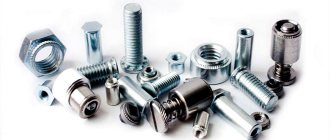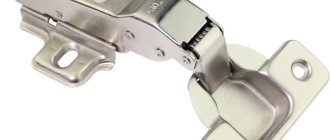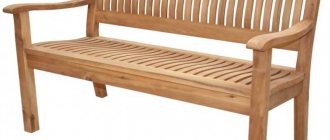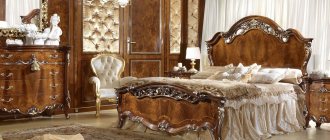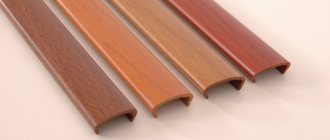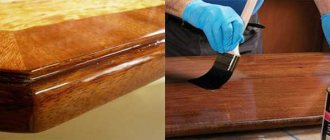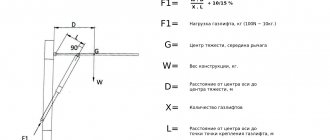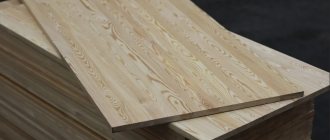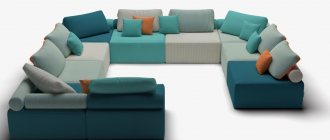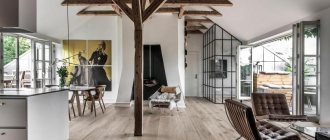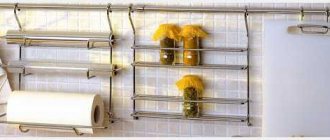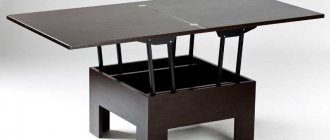Furniture screed is used only in furniture production. When making furniture, you should not use traditional fasteners instead of furniture ties, because it has special properties that not only facilitate the assembly of furniture, but also allow you to hide the fasteners. Next, we will consider the most commonly used types of furniture screeds and their features.
Confirmat
The most common type of fastener is confirmat. At the same time the easiest to use. With its help, assembling furniture is easier and faster than using other types of furniture screed. Especially if during assembly you have to drill holes for fasteners yourself. Using a confirmat, two parts are connected at an angle of 90 degrees.
Fig.1.
Confirmat - used to connect parts at an angle of 90 degrees. The two parts are connected with 2 confirmed screws. The confirmat is installed at a distance of 3-7 cm from the end of the parts to be connected. To install 1 confirmation screw, you must first drill 2 holes in the parts to be joined: in the end of the first part for threads (drill diameter 5 mm), in the second part for the head (drill diameter 6 mm).
In order to tighten the two parts, you need to drill two holes. One in one part, with a diameter equal to the diameter of the confirmator head, the other, at the end of the second part, with a smaller diameter equal to the diameter of the threaded part.
As a rule, drills with a diameter of 6 and 5 mm are used for this, respectively. However, there is a combination drill available for drilling holes at the same time. It is very comfortable. There is no need to constantly rearrange drill bits or use two drills at the same time.
Fig.2.
Drill for confirmation. Allows you to make a hole for 1 confirmat screw in two parts at once, and also forms a recess for the confirmat head. Increases the speed of furniture assembly by at least 50%.
Confirmat is a universal fastener, but it has some disadvantages and application features.
Confirmat should be used simultaneously with the use of dowels. A dowel is a wooden rod with a diameter of 6-8 mm and a length of 20-30 mm (in the photo below, next to the confirmation). The dowel acts as a guide and does not allow parts to move during tightening.
Fig.3.
Connecting the parts using a dowel with a diameter of 6-8 mm and a confirmat. This joining method is used in factory furniture, for example furniture from IKEA. Provides high accuracy of joining parts.
Despite the fact that furniture assembled using confiramate can be assembled or disassembled, furniture made from laminated chipboard does not tolerate this very well. As a rule, after one disassembly, the furniture screed no longer holds well.
The confirmation should be wrapped carefully. The best option is by hand or with a screwdriver at low speed. Otherwise, the confirmation thread turns into a drill, which breaks the hole.
Fig.4.
Tightening of parts with confirmation. The tie is performed with a hand wrench or a screwdriver with a low rotation speed of the chuck. The screwdriver must have the correct tightening torque to prevent thread stripping.
In order to recess the head into the body of the furniture part, you should use a wrench and do it carefully, otherwise there is a possibility of the thread breaking. Sometimes it is necessary to pre-calculate.
Con fasteners. Those. Unlike other types of fasteners, it remains visible, so it is necessary to use special plugs or stickers to hide the fasteners.
Fig.5.
Plastic plugs (linings). Used to hide the confirmat's cap. They are attached to the confirmation cap in the key groove and are held in place by a specially shaped core. Available in various colors.
Fig.6.
Self-adhesive overlays for confirmat. Designed to hide the cap. They have a wide range of colors, completely identical to chipboard panels. Almost invisible on furniture.
Varieties
There are several types of modern fastening, for example, shelf holders. They are available for chipboard and glass. When mounting wooden parts with fixation, an eccentric mechanism is used. It consists of a rod, which is screwed into the wall of the structure, and a supporting part, installed in the shelf using a self-tapping screw. During assembly, the rod must be placed in the eccentric groove and tightened. This connection method strengthens the structure. Shelf holders for glass are:
- with a suction cup that allows you to fix the part;
- overhead with a rubber and plastic cover;
- with a clamp in the form of a screw or fastener, with a gasket made of soft material.
Also, the elements of the furniture screed may differ in their design or installation method, for example, invisible and built-in elements differ. Some types of fastening require tools for milling and drilling, with an accuracy of up to 1-2 mm. Eccentric and tapered couplers are installed using precision machines, and the countertop requires a Forstner drill.
Scope of use of overhead furniture hinges, their features
With suction cup
Invoices
Confirmat
Confirmat is an easy-to-install type of fastening. It is needed to assemble 2 parts at right angles; it refers to invisible fastener models. The Euro tie consists of a pin with a cap, similar in shape to a self-tapping screw, and has a cut end and a large thread. On its lower part there are notches that allow you to make a notch in the finished hole at the moment of tightening. This gives additional strength and stability to the mount. To connect the parts you need to make 2 holes:
- the first - under the mounting head;
- the second - under the thread notch.
For this furniture screed you need a 6 and 5 mm drill or a combination drill, which is intended for such an assembly. This method is used when installing parts made of wood or chipboard in combination with a furniture dowel (with a wooden or plastic rod) as guides. It is also used to carry out a carriage tie.
The confirmat should be tightened manually, as a screwdriver can deform the hole, so the parts will fall apart during use.
Eccentric
The eccentric fastening method is used in industrial enterprises due to the fact that it is necessary to use a drill for furniture screed and expensive equipment. It makes it possible to hide connection elements. This type of fastening consists of 3 parts:
- A rod or stud that has a head with a hole for an installation tool and is inserted into one part of the structure.
- Decorative plug.
- Eccentric. This is a clamp installed in the second fastening element.
Drilling a groove for such a screed is done using a Forstner drill, and the depth of the hole should not exceed 12 mm (the thickness of a standard laminated chipboard sheet is 16 mm). There is specialized equipment that mills holes for parts. The eccentric connection allows the structure to be reassembled without harm to the fasteners. This installation method also makes it possible to mount parts at oblique angles.
Intersectional
An intersectional screed is needed to connect several parts of the interior into one solid fragment, for example, for cabinets or mezzanines. This fastening consists of a threaded pin and a bushing. For installation, you should align both sets for the screed exactly and make holes in their walls. After this, you need to insert the sleeve on one side and the mounting screw on the other. Despite the fact that there are notches for screwdrivers or hex keys on both parts of the part, it is the screw that needs to be tightened. The head on the bushing is needed to fix it during installation and prevent the tie from turning. To connect structures you need 2-4 intersectional fasteners. They should be placed closer to the corners, as this will increase the strength of the screed. There are parts of different lengths that need to be selected to match the overall wall thickness.
Types of furniture guides, their installation and selection criteria
Corner
Corner ties are plates with holes that are bent in the middle. This installation method is fragile, so it is used to assemble elements that will not bear much load. Most often, decorative parts or mezzanine shelves are connected with ties. Such fasteners are made of metal or plastic. The furniture corner is mounted using self-tapping screws that are screwed into the holes.
There is also a type of tie for attaching the legs of a table, chair or bed. This design connects the side parts of the furniture to each other, leaving a small space for a corner piece into which a threaded pin is inserted. There is a hole in the tie for inserting a rod and screwing a nut or screw onto it. This type of installation stands out greatly, so it is replaced with confirmat, another invisible fastener.
Screw
A screw tie consists of a steel cylinder with a hole made across it, as well as a pin with a head. This fastening method has a large tightening stroke due to the thread, which is machined along the entire length of the part. This gives furniture with such a connection high strength under lateral loads. This type of assembly is used to make chairs.
If the fastener becomes loose, it can be tightened to improve the stability of the structure. The screw fastener makes it possible to reassemble furniture without damaging the mechanism. The disadvantage of such fasteners is that to use them you need to have skill and special equipment. During installation, you should accurately match the holes for fastening, since it will be difficult to pull the barrel out of the groove. Visible parts of the mechanism can be covered with decorative plugs.
Conical
Conical couplers are used to connect thick panels made of wood or chipboard, as well as frame facades. The thickness of such parts is 25–38 mm. The mechanism is similar to a screw tie. The difference is that the rod is attached to the drilled flat part of the part. The screed has 2 holes:
- For a rod that is screwed into a panel.
- For a screw with a conical socket at one end and a thread at the other.
The disadvantage of this assembly method is the small stroke of the screed. Also, the tension screw is made of silumin, so it has a limited number of assemblies and disassemblies and a short operating time.
To re-install the structure, it is necessary to change this fastening element.
For table top
For furniture that consists of several collapsible elements, a “tabletop screed” is needed. To install it, you need to use a Forstner drill to make one recess in each part. Between them you need to make a groove for a clamp (threaded pin). A static part with a C-shaped washer is placed in one of the holes. After this, a nut with a curved plate is tightened on the opposite side of the groove, like at the other end of a clamp. Most often, this assembly method is used to tie together a furniture table. There is also an option using a part in the form of a washer (instead of a C-shaped one), which is attached on one side, and on the other - a bolt with a wide head.
Types of accessories for upholstered furniture, functionality and characteristics
Furniture dowel
A dowel is used for furniture ties. It is used to center and stabilize parts. Also, such fasteners reduce the lateral load on other connecting elements. Furniture dowels are most often made of wood; iron and plastic are less commonly used. This fastening method is used in combination with confirmat or other types of connection.
The most common dowel model measures 30 mm in length and 8 mm in diameter. On the surface of this part there is a grooved notch, which increases the adhesion strength. The furniture dowel is mounted into drilled holes, which can be pre-filled with glue for greater stability. The disadvantage of this type of fastening is that over time the wood and the sealant will dry out, so the structure will begin to wobble.
Eccentric coupler
An eccentric coupler is often used in the factory production of furniture. The reason for this is the difficulty of drilling holes. An eccentric coupler consists of two parts: a pin and an eccentric. The pin is installed in one part, and the eccentric in another.
Fig.7.
An eccentric coupler is used to conceal the connection of two parts at an angle of 90 degrees. To connect 2 parts you need 2 eccentric couplers. The eccentric coupler is installed at a distance of 5 cm from the end of the parts to be connected. To install the eccentric coupler, you need to drill several holes according to the diagram. Instead of a rod with a length of 34, a rod with a length of 26 mm (shortened) can be used, while the remaining dimensions remain unchanged.
The main advantage of this type of fastener is that this fastener is hidden and therefore does not spoil the appearance of the furniture. In addition, this type of fastener, unlike confirmat, allows you to repeatedly assemble and disassemble furniture, which is important, for example, when moving. Also, using an eccentric coupler, you can connect parts at different angles.
When making furniture yourself, it is not often used due to the difficulty of drilling holes and the inability to correct the joint during assembly. The main difficulty in drilling holes lies in the hole for the eccentric. This hole is not through and requires the use of a special drill - a Forstner drill.
Fig.8.
Forstner drill - used for milling blind holes for an eccentric. For a standard eccentric, a drill with a diameter of 15 mm is required.
Fig.9.
Hole for eccentric. First, mark the part according to the diagram given above. Next, use a Forstner drill to make a hole for the eccentric. Then, using a drill with a diameter of 8 mm, a hole is drilled in the end of the part for the rod.
Fig. 10.
Scheme of connecting parts using an eccentric coupler. First, the rod is installed in one part and the eccentric in another. Then the parts are connected and fixed by turning the eccentric clockwise through an angle of 180 degrees.
In this case, the sampling depth is about 12 mm, and the thickness of the chipboard is 16 mm. The remaining wall thickness is only 4 mm. There is a risk of drilling more than necessary, thereby damaging the piece of furniture. Therefore, when drilling holes for an eccentric tie, it is necessary to use drilling depth limiters.
Fig. 11.
Stopper for drilling holes for eccentric tie rods. Allows you to make a hole of a fixed depth. Protects furniture parts from damage when drilling.
Types of fasteners
Today, in the manufacture of any type of furniture, the following types of ties are used, which significantly simplify the process of assembly operations and increase the strength of structures:
- confirmat, which is often used in conjunction with decorative plugs;
- metal and wooden dowels;
- eccentric couplers;
- intersectional ties;
- connecting corner;
- special types of fasteners and accessories.
Let's take a closer look at each category of furniture fastening and assembly fittings and the features of their use.
Confirmat
Confirmat (furniture screw, self-tapping screw) is not only the most common type of fastening elements for furniture, but also the easiest to use. It is mainly used when joining two furniture boards at an angle of 90.0°. When installing the structure, it is necessary to comply with certain requirements to ensure the durability and strength of the product as a whole:
- distance from the edge of the part to the first screw;
- pitch between individual fasteners;
- correspondence of the diameter of the hardware to the thickness of the slab.
On a note!
To connect two parts, it is necessary to drill holes of different diameters. In the main part it must correspond to the body of the screw, and in the attracted part it must correspond to the diameter of its head. For drilling, special confirmat drills are used, the body of which has a stepped diameter.
The use of this type of fastener has its own specifics and has a number of disadvantages:
- to increase the accuracy of assembly, dowels are used, which are the base (guide) elements;
- samples made from laminated particle board do not withstand repeated assembly and disassembly;
- when tightening the confirmat, control of the force is required;
- When using a screwdriver, screwing is carried out at minimum speed.
On a note!
To mask the screw head, either decorative plugs or self-adhesive stickers are used. The plugs have a color that quite accurately matches the color of the furniture board, and the stickers completely imitate the texture of the surface.
Eccentric couplers
In the industrial production of various pieces of furniture, eccentric couplers are widely used. When making interior products yourself, this type of fastener is not widespread due to the complexity of drilling holes, which requires high precision, and some types of eccentrics require special tools.
The design of the coupling element consists of two parts - an eccentric and a pin, which are installed in two different parts, connected at an angle of 90.0°. The main advantage of this connection method is its secrecy. It does not affect the appearance of the furniture product and does not require additional masking. No less important is the ability to repeatedly assemble and disassemble the structure without compromising the strength and rigidity of individual parts. There are special types of eccentric couplers that allow you to connect furniture boards at angles other than straight.
On a note!
To install the eccentric, a special drill is required, so the developers try to unify the eccentric diameter as much as possible. Most samples have a diameter of 15.0 millimeters. The Fosner drill used for drilling blind holes for the eccentric eliminates the need to create a larger depth in the slab than necessary.
Assembly and connection of hotel furniture parts is carried out in the following sequence:
- an eccentric is inserted into a blind hole drilled on the base (main) part;
- a rod (pin) is passed through the through hole of the second part;
- the pin is screwed into the eccentric body;
- after this, the eccentric is turned and fixed;
- the parts are attracted to each other and the necessary connection force is ensured.
Intersectional
An intersectional coupler is a specially shaped screw and nut that allows parallel furniture panels to be connected to each other. This type of fastening hardware is most widely used in the assembly of modular and sectional furniture. The number of connecting elements is selected depending on the area of the connected planes. The nuts have different lengths, which depend on the thickness of the panels being joined.
On a note!
This type of fittings is widely used in self-assembly of modular furniture. Before starting assembly work, individual sections or modules are fixed to each other using clamps. After this, holes of the appropriate diameter are drilled in the joining surfaces according to preliminary markings.
The design of the tension connector allows you to easily reformat modular sets, creating from individual sections the most diverse interiors in design, layout and shape. If, when reformatting the modules, the holes for the screed become unnecessary, they are simply masked with decorative plugs.
Furniture corners
Furniture corners are gradually becoming a thing of the past, but are still widely used in the independent or individual production of home furnishings. Today the industry produces:
- metal (power) corner fastening fittings;
- plastic corners that are used for fastening and installing auxiliary or decorative elements.
Power corners are fastened using special furniture bolts or insertion threaded sockets, and installation is not difficult and can be carried out using glue.
Special types of ties
Often, when creating exclusive furniture, designers provide for the use of unique connecting and fastening elements, manufactured in single copies. Of the special types of screeds, the most widespread are fasteners for countertops. It is designed to connect two separate halves of the dining table planes into a single whole.
A hairpin and two “C”-shaped ones are installed in the lower plane of the tabletop, which requires drilling a cylindrical recess in it and milling a groove. The minimum number of ties per table is two.
In addition, various types of shelf holders are widely used among fastening and connecting fittings.
Intersectional screed
This tie is a screw and nut with which two sections of furniture are pulled together, for example, two cabinets. To tie cabinets, 2 - 4 intersectional ties are used. Depending on the thickness of the chipboard, there are intersection screeds of various sizes.
Fig. 12.
Intersectional screed is designed to connect cabinets (sections) of furniture to each other. To tie 2 cabinets you need 3-4 intersection ties. The intersectional screed is installed near the corners (at a distance of 3-5 cm from the end) of the sections being connected.
Considering that the intersection screed is used to tie cabinets, and the cabinets, in turn, are made of laminated chipboard with a thickness of 16 mm, an intersection screed with a length of 32 mm is most often used. However, there are ties up to 50 mm long, which are used to tighten parts of greater thickness.
Fig. 13.
Screeding cabinets with an intersectional screed. To install the screed, you need to secure the cabinets using clamps. Next, make a hole with a diameter of 9 mm (1 mm larger than the diameter of the tie). Then install and secure the screed.
Screed for sections
The clamp for individual sections is designed to assemble a solid furniture corner from the modules. The product is a bolt with a head that has a large diameter. It screws into a nut that looks like a hollow bolt. The size of such a screed varies depending on the thickness of the chipboard sheets it is designed for. Installation of such an element is simpler than the previous two. It is enough to firmly fix the parts that need to be fastened with a clamp. After this, a through hole is drilled and a tie is mounted, which is tightened with a screwdriver.
Shelf supports
There are a huge number of types of shelf supports. However, they can be divided into two groups: shelf holders for chipboards and shelf holders for glass. In turn, each of these groups can be divided into two types: shelf holders with and without fixation.
The shelf holder for chipboard consists of 2 parts: a rod and a shelf holder.
Fig. 14.
The shelf holder for laminated chipboard is designed for reliable fastening of shelves in the closet. Available in two types, with and without fixation. Fixation is ensured by an eccentric. The shelf holder is installed in the shelf, the rod in the cabinet wall. To attach 1 shelf you need 4 shelf supports.
The screw is installed in the cabinet wall, and the shelf holder is installed in the body of the shelf. To install the shelf holder, you need to drill holes in the shelf and cabinet wall. For most shelf supports, the hole sizes are standardized; they are shown in the figure below. However, when installing the shelf support, you should carefully read the instructions to avoid errors.
Fig. 15.
Hole pattern for shelf holders for chipboard. A hole is made in the shelf with a Forstner drill for installing the holder. There is a hole in the wall for the rod using a wood drill. The shelf holders are located at a distance of 5 cm from the front and rear ends of the shelf.
Next, the shelf holder is installed in the prepared hole. To do this you need to use a rubber hammer. This way the shelf holder will be firmly fixed in the shelf.
It should be noted that shelf holders for chipboard come with or without fixation. The shelf holder with fixation has an eccentric mechanism, thanks to which the shelf will be firmly connected to the cabinet wall. Shelf supports with fixation have one more advantage; shelf supports of this type serve as additional reinforcement of the furniture structure.
Fig. 16.
Shelf holder for chipboard with fixation. Analogue of an eccentric coupler. Additionally strengthens the structure of the furniture and increases the rigidity of the cabinet. The shelf holder provides the ability to remove and rearrange the shelf many times without damaging the furniture.
Glass shelf holders have a simpler design. They are attached only to the cabinet walls using a self-tapping screw.
Fig. 17.
Shelf holder for glass. To install 1 glass shelf you need 4 shelf holders. The shelf holders are secured with self-tapping screws 16 mm long to the cabinet walls at a distance of 5 cm from the front and rear ends of the cabinet.
Shelf holders for glass without fixation are a rod or an angle. Shelf holders with fixation have a special screw with which the glass is firmly fixed and cannot accidentally fall out.
Fig. 18.
Shelf holder for glass. The glass is fixed with a screw on the bottom side of the shelf holder.
Table top screed
A special type of screed is required to connect two parts of a table top. Used in the manufacture of kitchen furniture.
Fig. 19.
Screed for table tops. Provides a reliable connection between two parts of countertops. To increase the accuracy of joining parts, it is advisable to use it together with a dowel. For a standard screed, non-through holes with a diameter of 35 mm and a depth of 19 mm are made in the connected parts of the tabletops. The distance between the holes should be 15 mm less than the length of the tie. The groove width must be at least 7 mm.
To tie two tabletops together, use a pair of ties. To install the tie rods, it is necessary to make recesses for the tie rod stops and a slot for the screw. This can be done in various ways. The most affordable option is the following. The recess for the stops is made with a Forstner drill of a suitable diameter; the slot for the screw can be made using a jigsaw.
Fig.20.
Connecting table tops with a screed. At least 2 ties are installed for connection. To install the screed, holes and a groove are milled in the tabletop slab. The holes can be made with a Forstner drill, the groove can be cut out with a chisel, or using a hand router.
Instructions for creating holes for an eccentric tie
Step No. 1 – mark the drilling locations. Before you begin installing the hitch, you must accurately mark the places where the necessary holes will be drilled. You can mark manually using a ruler or template, or you can use a special device - a jig. We'll talk about it below.
First of all, you need to mark the places for attaching the screed using a ruler or template.
Step No. 2 - drill a place for the rod. Next, in one of the two parts to be connected, we drill a groove for the rod. It is important that it does not go through, so use a stopper. We screw in the rod, leaving it to protrude 6 mm above the blade.
Next, you need to drill grooves in the material, into which the rod will be inserted later
Step No. 3 - make a groove for the eccentric. The next step is to drill a hole for the eccentric. This is done using a Forstner cutter. And here the depth is important, on average 15 mm will be enough. The groove should not be through, the eccentric should fit into it to its full height and be flush with the surface of the workpiece. On the product, using a template or ruler, measure a distance of 33.5-34 mm from the bottom edge and 5 cm from the side end. The intersection point will be the center of the hole.
The hole for the eccentric segment of the connection is drilled using a special cutter
Step No. 4 - drill a passage for the rod. And the final stage in preparing places for fastening will be drilling a passage for the rod in the same element in which we will place the eccentric, only from the end side of the part. It is done with an 8 mm drill and should be located exactly relative to the center of the niche for the eccentric and exactly in the middle of the end part of the part itself. When working, it is important to use a ruler, tape measure, or, if you have a special jig, a template. Otherwise, misalignment of the grooves may result in you not being able to assemble the furniture neatly and evenly.
Next you need to drill a passage for the rod
The holes are ready and all that remains is to connect the parts of the future structure. To do this, we apply one workpiece to another so that the rod enters the passage. We insert the eccentric into the groove and use a Phillips screwdriver to tighten the minifix, thereby firmly and securely fastening the furniture elements together.
Provided that you followed the instructions carefully, the furniture connection will be installed without problems
With correct and accurate calculations and following all instructions, your furniture pieces should fit perfectly into a single plane, without protrusions or distortions.
Furniture corner
This type of fastener is used to connect two parts. This is a rather fragile connection method, so it is used to fasten parts that are not expected to be affected by heavy loads. Usually these are decorative elements, for example, the base of a wardrobe or mezzanine shelves.
Fig.21.
The furniture corner is used for fastening decorative furniture elements (plinth) and installing shelves. Made from plastic. It has a cover to hide the fasteners. Self-tapping screws 16 mm long are used as fasteners.
Plastic corners are often used instead of metal ones. They are no less durable, but have a more attractive appearance and the possibility of hidden fasteners. The furniture corner is attached to two mating parts using two self-tapping screws. Then the lid is snapped on, thus hiding the fasteners.
Fig.22.
A furniture corner is used for fastening low-load furniture elements, including for installing decorative elements such as a plinth, inserts, etc.
The furniture fasteners discussed in the article are the most common and most frequently used, due to the fact that these are the most versatile and easy-to-use types of fasteners. In the vast majority of cases, the types of furniture fasteners described are sufficient to assemble any furniture.
Advantages and disadvantages
Like any type of fastener, an eccentric connection has its positive and negative sides. Let's look at them using a table as an example.
Table 1. Advantages and disadvantages of an eccentric coupler
| Advantages | Flaws |
| 1. Furniture can be assembled and disassembled quickly and effortlessly. 2. Possibility of repeated assembly and disassembly of products. 3. The most reliable and durable mounting option. 4. Does not spoil the appearance of the product. 5. Possibility of fastening products at different angles. | 1. High price of fasteners. This increases the cost of the product as a whole. 2. The installation technology is quite complex. 3. The need for perfectly accurate calculations for marking locations for fastenings. |
What does an eccentric coupler look like when it's in place?
